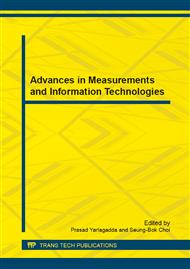[1]
J. Szynowski, CMRR analysis of instrumentation amplifiers, Electronics Letters. 19 (1983) 547-549.
DOI: 10.1049/el:19830371
Google Scholar
[2]
R. P. Areny, J. G. Webster, Common Mode Rejection Ratio for cascode differential amplifier stages, IEEE Transactions on Instrumentation and Measurement. 40 (1991) 677-681.
DOI: 10.1109/19.85333
Google Scholar
[3]
R. P. Areny, J. G. Webster, Common mode rejection ratio in differential amplifiers, IEEE Transactions on Instrumentation and Measurement. 40 (1991) 669-676.
DOI: 10.1109/19.85332
Google Scholar
[4]
K. A. Ng, P. K. Chan, A CMOS analog front-end IC for portable EEG/ECG monitoring applications, IEEE Transactions on Circuits and Systems Part-I 52. (2005) 2335-2347.
DOI: 10.1109/tcsi.2005.854141
Google Scholar
[5]
S. J. G. Gift, B. Maundy and F. Muddeen, High-performance current-mode instrumentation amplifier circuit, International Journal of Electronics. 94 (2007) 1015-1024.
DOI: 10.1080/00207210701751188
Google Scholar
[6]
K. Koli, K. A. I. Halonen, CMRR enhancement techniques for current-mode instrumentation amplifiers, IEEE Transactions on Circuits and Systems Part-I, 47. (2000) 622-632.
DOI: 10.1109/81.847869
Google Scholar
[7]
S. Maheshwari, High CMRR wide bandwidth instrumentation amplifier using current controlled conveyors, International Journal of Electronics. 89 (2002) 889-896.
DOI: 10.1080/0020721031000120452
Google Scholar
[8]
E. L. Douglas, D. F. Lovely, D. M. Luke, A low-voltage current-mode instrumentation amplifier designed in a 0. 18-Micron CMOS technology, Proceedings of Canadian Conference on Electrical and Computer Engineering. (2004).
DOI: 10.1109/ccece.2004.1349760
Google Scholar
[9]
C. -W. Liao, J. -C. Chou, T. -P. Sun, S. -K. Hsiung, J. -H. Hsieh, Investigation of the amperometric/potentiometric dual mode glucose biosensor, Sensor Letters, 6 (2008) 836-839.
DOI: 10.1166/sl.2008.512
Google Scholar
[10]
H. Wu, Y. -P. Xu, A low-voltage low-noise CMOS instrumentation amplifier for portable medical monitoring systems, Proceedings of IEEE NEWCAS. (2005).
DOI: 10.1109/newcas.2005.1496659
Google Scholar
[11]
H. Wu, Y. -P. Xu, A 1V 2. 3μW Biomedical Signal Acquisition IC, Proceedings of IEEE International Solid-State Circuits Conference. (2006).
DOI: 10.1109/isscc.2006.1696040
Google Scholar
[12]
W. T. Holman, J. A. Connelly, A compact low noise operational amplifier for a 1. 2 um digital CMOS technology IEEE Journal of Solid-State Circuits. 30 (1995) 710-714.
DOI: 10.1109/4.387078
Google Scholar


